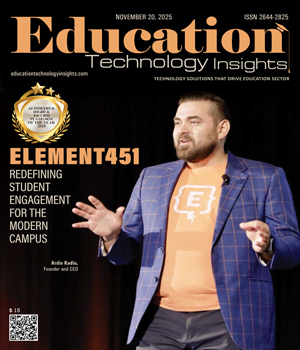THANK YOU FOR SUBSCRIBING
Be first to read the latest tech news, Industry Leader's Insights, and CIO interviews of medium and large enterprises exclusively from Education Technology Insights
Humanizing the Digital: Faculty, AI, and the Transformation of Learning
Jean Mandernach, Professor, Grand Canyon University
 Jean Mandernach, Professor, Grand Canyon University
Jean Mandernach, Professor, Grand Canyon University
Career Milestones: Tech to Teaching Leadership
My path to becoming Executive Director of the Center for Innovation in Research and Teaching at Grand Canyon University stems from a deep and enduring fascination with educational technology. This journey began in the 1990s. While initially drawn to the exciting possibilities of technology in education, I always tempered my enthusiasm with a healthy dose of critical inquiry. I consistently asked questions like: How will this technology impact student learning? What evidence demonstrates its effectiveness? For the past three decades, this line of questioning has driven my research into educational innovations. Now, at the Center, we leverage this approach to guide faculty in critically evaluating the impact of technology on learning. We ensure that any innovation we pursue is rooted in meaningful, research-driven practices, ultimately prioritizing enhancing the learning experience.
“AI's potential is transformation, not just efficiency, shaping a more adaptive, personalized, and innovative future”
Supporting Faculty Innovation: NeedsDriven, AI-Powered
Institutions often overwhelm faculty with endless new technologies and teaching strategies, expecting them to choose what works. This misses the mark. Instead of leading with tools, we should focus on teaching fundamentals— helping faculty identify student challenges, learning barriers, and pressing needs within their discipline and objectives. Then, we can introduce fitting strategies and technologies.
Traditional faculty training in digital and hybrid learning relies on webinars, videos, and static websites. While useful, these lack personalization. AI offers customized, individualized support. AI-driven chatbots can guide instructors through a structured process to pinpoint instructional challenges, explore targeted solutions, and master high-impact strategies. This shift to a tailored, needs-driven model is key to effectively supporting faculty innovation.
AI's Role in Teaching: Enhancement, Not Replacement
AI will enhance, not replace, traditional teaching. Effective teaching relies on timeless principles: clear objectives, engaging experiences, inclusivity, student-centered learning, feedback, critical thinking, real-world connections, and adaptability. AI doesn't change these. The challenge is teachers' limited time and attention. AI excels here, providing instant, personalized feedback at scale.
With AI handling routine tasks, educators can focus on interactive, social learning. Because learning is social, AI allows teachers to engage more meaningfully and be free from administrative burdens. AI's full impact is unfolding, but it promises more time for deeper discussions, collaboration, and mentoring—enriching the human side of education.
Post-Pandemic Teaching: Transition, Not Failure
Institutions returning to pre-pandemic models aren't necessarily rejecting digital methods but instead seeking the social engagement of in-person learning. This isn't failure, but transition. The rise of AI during this period has further disrupted the landscape, leading to overwhelm and a return to familiar methods for stability. It's too early for a clear path. Institutions need to assess their specific contexts.
Critically, any pre/post-pandemic teaching discussion must acknowledge AI's massive, ongoing impact. This isn't a failure to progress but a recognition that education is undergoing multiple, overlapping shifts. The integration of digital, hybrid, and AI strategies is still unfolding.
Measuring Online Learning Impact: Beyond Simple Metrics.
This reveals a bias: online programs often face stricter effectiveness scrutiny than on-campus ones. The real issue is how we measure learning. We've long relied on imperfect proxies—tests, papers, projects—despite their limitations. If in-person programs are assumed to produce learning, online programs may try to show equivalent outcomes. However, this ignores that online and face-to-face students often differ in background, challenges, and needs.
Direct outcome comparisons assume identical conditions, which is rarely true. Instead of proving online equivalence, we should ask: How do we measure authentic learning in any modality? How can we move beyond outdated proxies to assess actual knowledge, skills, and critical thinking? The issue is redefining learning effectiveness as a whole.
Learner Engagement's Future: AI & Faculty Collaboration
Learner engagement in digital education is evolving with AI-driven, individualized learning. As students use AI for content, faculty will focus on application. Instead of delivering content, they'll guide deeper engagement, encouraging critical analysis, synthesis, and real-world application.
Faculty will shape the experience by defining objectives and creating active engagement opportunities: discussions, projects, and collaboration. While AI personalizes pathways, faculty provide intellectual and social scaffolding, ensuring learning leads to fundamental understanding and practical skills.
Navigating the Digital Shift: Embrace Transformation
My advice to university leaders navigating the digital shift: move beyond assimilation to accommodation.
Many are currently using AI to enhance existing models. Once comfortable with AI's capabilities, we must rethink and reimagine education. We must explore new models and methods AI enables, not just improve current ones. AI's potential is transformation, not just efficiency, shaping a more adaptive, personalized, and innovative future.
Read Also
Goldilocks Regulation
Beyond the Quiz: Redefining Competence in eLearning
Beyond Theory and Into Monday Morning: Enhancing Graduate Programs for Teachers
Safeguarding Students in the Age of Deepfakes: An Educational Imperative
Delivering Excellence in Education through Transformative School Leadership
Curriculum Innovation for Student Success and Institutional Growth

I agree We use cookies on this website to enhance your user experience. By clicking any link on this page you are giving your consent for us to set cookies. More info

However, if you would like to share the information in this article, you may use the link below:
www.educationtechnologyinsightsapac.com/cxoinsights/jean-mandernach-nid-3123.html




















